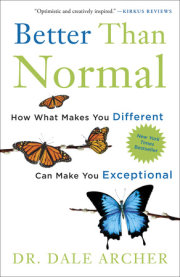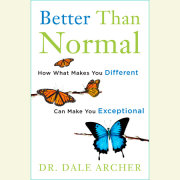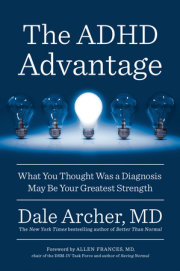ONE the eight traits
And it ought to be remembered that there is nothing more diffi cult to take inhand, more perilous to conduct, or more uncertain in its success, than to takethe lead in the introduction of a new order of things. Because the innovatorhas for enemies all those who have done well under the old conditions, andlukewarm defenders in those who may do well under the new.— Niccolò Machiavelli It’s time for the introduction of a new order of things in the world of mental health. As a psychiatrist, I feel called to look critically at the overdiagnosing and overmedicating of America. More important, I am driven to spread an empowering new message
about mental disorder that places responsibility for identity and mental health back where it belongs— in
your hands.
I am envisioning a real change in the way we all talk about what it means to be ourselves. I believe that by understanding the eight fundamental behavioral traits and by seeing them as part of a continuum, we can really make a positive change in the way we understand ourselves. By the time you finish this book, I hope you will be able to see that every one of us has
all of these traits, to some degree, and can analyze where each of our traits falls on a one- to- ten continuum (more on this in a moment). You’ll be able to say:
“I’m an eight on the ADHD continuum.”“I am a seven on the narcissism continuum.” “I am a seven on the bipolar continuum.”“I am a two on the OCD continuum.” What’s more, you should be able to recognize exactly how your dominant traits have aided you in the past. “I would never have had the desire to do that ten- day solo sailing trip if I wasn’t an ADHD eight,” you might say, as I do. Or even better: “I have all the strengths I need to go on that trip I’ve always dreamed of. There’s nothing to stop me now.”
Here’s a story for you. It’s about me, but it could easily be about you or lots of other people.
One day when I was in fifth grade, my homeroom teacher called in sick and we had a substitute teacher for the day, whom I’ll call Ms. J. When this young woman walked into the classroom, I was pretty sure I understood what she was all about.
I decided to see if I was right about her. To do so, I would perform a series of experiments. My first one involved spitballs. I’m not sure if kids still shoot spitballs, so let me give you a quick primer on this technique:
1. Tear off small bit of paper, ideally from homework assignment.
2. Wad up paper, place in mouth, and moisten with saliva (aka spit).
3. Remove paper from mouth and compress into hard little ball.
4. Insert ball into one end of straw, place mouth at other end.
5. Blow hard.
I prepared the first spitball and waited until Ms. J was at the blackboard with her back turned.
Ptooey! The spitball shot across the room and hit the neck of a kid in the first row. Ms. J faced us. If she noticed the disruption, she didn’t let on. Oh my, yes, I was quite right about her. I followed up on my experiment by sending several rubber bands zinging across the room before upping the ante to a whole new level: paper airplanes.
That did it.
My airplane missed its kid target and nailed Ms. J’s right kneecap. She gasped. She turned red. She looked on the brink of tears. She hastily departed the room and, a moment later, returned with the assistant principal, Mr. B. Without hesitation, he called me to the front of the room and glared at me. “D,” he said sternly. (D was my nickname in school.) I slumped a bit. “Yes?” Mr. B spoke in a low, controlled tone. “If you don’t behave, I will have to call your parents. I will tell your mother and father that you have been disrupting class and that someone will have to come get you and take you home.”
Despite the way this story makes me sound, I was actually a pretty obedient kid. I told Mr. B that I would behave. I apologized to Ms. J. I went back to my desk. Mr. B departed. I leaned my chair up against the wall. Ms. J continued the lesson. I fell asleep.
I feel a little bad when I tell this story. Ms. J was probably a shy woman whose personality type was not particularly well suited to substitute teaching fifth graders. So let me take this opportunity to apologize (again) for ruining her day. Sorry, Ms. J!
My spitball story provides a textbook case of the condition called attention deficit/hyperactivity disorder, or ADHD. Symptoms include inability to focus, acting out, and fidgeting. According to traditional ways of thinking about this disorder, when such symptoms become disruptive— as they did that day in Ms. J’s class— they are no longer considered normal personality traits. They become abnormal, signaling a mental disorder that needs to be treated, usually with a combination of therapy and medication, typically a psychostimulant such as Ritalin or Adderall.
What’s more, anyone who exhibits the symptoms— and goes in for treatment— is labeled mentally ill. They are categorized, stigmatized, and often scarred for life. Good thing for me that my escapade didn’t occur recently or I might have been taken to a doc and medicated on the spot!
This is the traditional way of thinking about certain personality traits. My mission is to do whatever it takes to blow that thinking out of the water. And I’ll use every tool at my disposal to do so, including, if necessary, spitballs.
Copyright © 2012 by Dr. Dale Archer. All rights reserved. No part of this excerpt may be reproduced or reprinted without permission in writing from the publisher.











